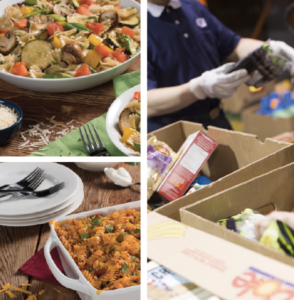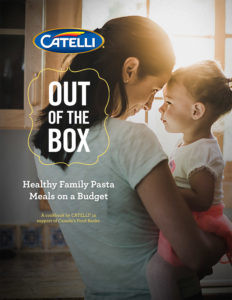By Lily Huang

Each month, 860,000 Canadians receive support from Food Banks Canada. This is a 28 per cent increase from the 2008 economic downturn and the need for resources is quickly increasing. The food community – from manufacturer through to retailer – has always stepped up to the plate to fill this essential need.
In March, the Walmart Foundation offered a grant of $4.6 million to Food Banks Canada to bring high volumes of quality food, refrigeration, transportation, forklifts, and storage facilities to Canadians in need.
In addition, 15 of Canada’s top chefs and dietitians have come together to create nutritious and budget-friendly recipes compiled in a cookbook called, Out of the Box: Healthy Family Pasta Meals on a Budget. The cookbook was launched as part of a campaign called Help us Feed the Hope, an initiative by Catelli Foods in support of Canada’s food banks. For every share or download of the cookbook and its recipes, Catelli will donate servings of pasta to food banks across the country, with the goal of donating a total of one million servings. Complete with top food picks and health tips from the dietitians, the cookbook – which features recipes that can be made for a maximum of $15 for a family of four – is available for free download.
Marzena Gersho, Director of Communications and National Programs for Food Banks Canada, describes her experience working to improve food security for Canadians.

How does Food Banks Canada work with food manufacturers to meet the needs of its clients?
Each month, we receive surplus food from grocery stores and our partnerships with different companies to prevent food from going to waste and provide for families in need. We have constant communication with manufacturers to maintain the consistency of high-quality food. We ensure that there is food handling integrity and that there are no risks for consumers such as packaging mishaps.
How do you ensure food from donors is safe to distribute?
We have a free food handling program which trains and educates employees about food safety standards and knowledge on how to reduce foodborne illnesses. It includes numerous resources available in French and English that identify issues with food safety practices and how to develop new methods to maintain safety for food bank recipients.
What is the most rewarding aspect of your work?
I love working with all the amazing people from the food banks and the valuable work we do has a good purpose. Especially with the grant, it’s great to see the excitement from volunteers and employees to be able to help families. There’s also excitement from those who come to food banks because they are able to receive nutritious food when they need it most.
Other than the food donations, how do food banks provide assistance for low-income families?
There are community kitchen programs that educate low-income individuals on how to use the food provided by the food bank, learn how to make different meals, plan menus, grocery shop on a budget, and read food labels to make good food choices. This is a networking opportunity for people to support and receive advice from one another. There are also community gardens that teach participants how to grow fresh vegetables in their own gardens.
 Canadian Food Business
Canadian Food Business




